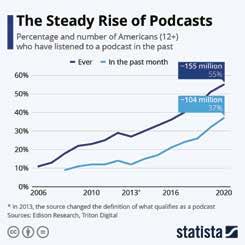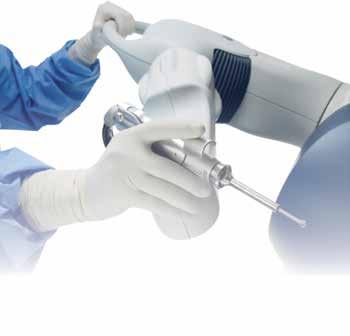
4 minute read
What the podcast?
The rise of the audio broadcast and what Northland women are listening to

By Abigail Blonigen
Podcasts are a seemingly new phenomena in the media sphere — or are they?
According to Statista, a business data platform that pulls statistics from all over the world, 55% of Americans had listened to a podcast at some point in their life, compared to 10% in 2006 and roughly 30% in 2014. Of those 155 million podcast listeners, 104 million, or 37% of Americans, had listened to a podcast in the last month.

Despite the rising numbers, the concept of a podcast — essentially a radio show — is far from new. According to PBS, radio programming began in 1920, an idea by Westinghouse radio manufacturer to sell more radios. Within four years of the first official “commercial broadcast,” 600 commercial radio stations popped up around the country, and the advertisers followed.
By today’s standards, famous radio and film personality Orson Welles could be considered a podcaster.
“I didn’t really know what a podcast was,” said Rachel Mae Downs, who started listening to podcasts in 2018. “I always thought podcasts were more like talk radio, which wasn’t really my thing.”
Now an avid listener, Mae Downs got into podcasts at the suggestion of a coworker. A lover of true crime and spooky stories, she started listening to “Scary Stories Told in the Dark” while driving and soon became hooked.
Women seem to have a particular appreciation for true crime podcasts. Media research company Edison Research reported in 2019 that true crime ranked No. 6 for women and No. 10 for men for content preferences. Mystery/thriller, in comparison, ranked No. 7 for both men and women.
The most popular content topic for women is wellness and selfimprovement, which did not rank in the top 10 of the men’s list.
While podcasts started primarily as a form of entertainment for Mae Downs, she soon began listening to podcasts focused on areas of her life she wanted to improve, sprinkling in motivational speakers, horse barrel racing experts and keto nutritionists into her rotation.
“It’s an opportunity to spend time working on my growth and having those positive reinforcements and stories of success to influence my life, having that in the background of my mind all the time,” she said.
Mae Downs likes to listen to podcasts when she is driving or when she is doing household chores, though she’ll still switch on music or the TV if she is in the mood. Other podcast fans interviewed by The Woman Today listen while working, walking or while getting ready in the morning. They all admitted to “binge listening” if they get really into a show.
Dr. Kelly Casperson, a urologist from Duluth who now resides in Washington state, has used podcasting as a means of destigmatizing and educating around women’s sexual health in her podcast
“You Are Not Broken.”
Casperson said she is now ranked in the top 100 for sexuality podcasts with over 70,000 listeners. She chose podcasting as her media because she does not like writing, and enjoys the conversational feel. She has also dabbled in video, posting educational content on YouTube, but finds podcasting comes a bit easier and doesn’t require as much editing.
“I love the spontaneity of (podcasting). I love the energy of it. I love how intimate it is,” she said. “When I listen to podcasts, I feel like I really know those people — they're in your car or wherever you're listening.”
The relationship with and between podcasters was something Mae Downs identified as being just as crucial as the story when she chooses a podcast to listen to. If she doesn’t jive with the personality or style of the speaker, she’ll opt for a different program.
What sets podcasts apart from their radiowave predecessors is streaming. The term “podcast” was coined by Guardian journalist Ben Hammersley in 2004, combining the words “iPod” and “broadcast,” according to Vulture entertainment news. iPods and other digital devices were becoming more portable and accessible and allowed listeners to completely customize what they wanted to hear, rather than having to flip through radio stations or tune in at the exact same time each week.
A podcast is also relatively easy to start — all one really needs is a microphone and some basic audio editing software to be online as quickly as the file can upload. There is no longer a need for a radio station’s equipment or platform.
Rather than needing to create a radio program that would appeal to the listenership of a specific station, podcasters can now hone in on their niche — be it board games or politics or kidnappings — and find listeners across the globe.
“I encourage everybody to give (podcasts) a try because there's really something out there for everybody,” said Mae Downs.
The Woman Today reached out to a handful of readers via Facebook about their favorite podcasts. Here are a few of their recommendations:
Transformingjoint Replacement With Mako Robotic Arm Assisted Technology

While many popular podcasts have their own websites one can stream from, most listeners stream through platforms such as Spotify, Apple Podcasts, Google Podcasts and Pandora. D Abigail Blonigen is a Duluth freelance writer.
Wh en yo ur joi nt sw ear ou ta nd need re pl ac em en t, co nsi der an inno va ti ve ap pr oach. La ke wa lk Su rg ery Ce nt er no w of fe rs join tr eplac em en tu ti lizing Ma ko Sm artr obo tic s™ te ch nolo gy– en abl in gy ou to ha ve am or ep er sona liz ed and pr ec ise su rg ic al ex perienc e. Ta lk to yo ur sur ge on to see if Ma ko is th er igh to pt ion fo ry ou .
1420 Lo ndon Ro ad ,D uluth |2 18-728-0650 lak ewa lk.c om










